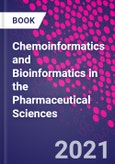Chemoinformatics and Bioinformatics in the Pharmaceutical Sciences brings together two very important fields in pharmaceutical sciences that have been mostly seen as diverging from each other: chemoinformatics and bioinformatics. As developing drugs is an expensive and lengthy process, technology can improve the cost, efficiency and speed at which new drugs can be discovered and tested. This book presents some of the growing advancements of technology in the field of drug development and how the computational approaches explained here can reduce the financial and experimental burden of the drug discovery process.
This book will be useful to pharmaceutical science researchers and students who need basic knowledge of computational techniques relevant to their projects. Bioscientists, bioinformaticians, computational scientists, and other stakeholders from industry and academia will also find this book helpful.
Please Note: This is an On Demand product, delivery may take up to 11 working days after payment has been received.
Table of Contents
1. Impact of Chemoinformatics Approaches and Tools on Current Chemical Research
2. Structure- And Ligand-Based Drug Design: Concepts, Approaches and Challenges
3. Advances in Structure Based Drug Design
4. Computational Tools in Cheminformatics
5. Structure Based Drug Designing Strategy to Inhibit Protein Protein Interactions Using in Silico Tools
6. Advance Approaches and In Silico Tools of Chemoinformatics In Drug Designing
7. Chem-Bioinformatic Approach for Drug Discovery: In Silico Screening of Potential Antimalarial Compounds
8. Mapping Genome by Using Bioinformatics Database and Tools
9. Python, A Reliable Programming Language for Chemoinformatics And Bioinformatics
10. Unveiling the Molecular Basis Of DNA-Protein Structure and Function: In Silico View
11. Computational Cancer Genomics
12. Computational and Functional Annotation at Genomic Scale: Gene Expression and Analysis
13. Computational Methods (In Silico) And Stem Cells as Alternative to Animals in Research
14. An Introduction To BLAST- Applications for Computer-Aided Design and Development
15. Pseudoternary Phase Diagrams Use In Emulsion Preparation
Authors
Navneet Sharma Scientist, Institute of Information Technology (IIT), Delhi, India.Dr. Navneet Sharma is an Assistant Professor at the Amity Institute of Pharmacy, Amity University, India. He has an M.Pharm, Ph.D and PGDRA, and his expertise lies in the realm of biomaterials and applied R & D, especially needs-based product development. He has taken pivotal roles as an investigator in three projects supported by DST-India. He has won several awards, including eight national and international awards. The most prestigious among them are SCO and Ministry of External Affairs, Government of India Covid-19 best innovation award 2020, and Department of Science and Technology, Young Scientist Award for the year 2018 and 2022. He has more than 40 publications including four books, five book chapters, 10 patents and 4 technologies successfully transferred to the industry.
Himanshu Ojha Division of CBRN Defense, Institute of Nuclear Medicine and Allied Sciences, New Delhi, India. Dr. Himanshu Ojha has a BSc, MSc, and Ph.D. in Chemistry Honors from University of Delhi. His Ph.D. work involved the design, synthesis and biological evaluation of s-triazine derivatives for antimalarial activity against Plasmodium falciparum. He is now a senior scientist in Division of CBRN Defence of Institute of Nuclear Medicine and Allied Sciences.He had extensively worked on DFT studies of bimolecular interactions and reaction pathways. He has designed quite large number of new drug like compounds for various applications using virtual computational algorithms, QSAR and molecular docking. He has worked extensively in the field of 2D and 3D Quantitative structure activity relation (QSAR) studies to identify lead compounds for various particular applications. He has 29 research articles in various peer reviewed international journals, one book chapter and edited one book and 03 intellectual property rights. Pawan Raghav BioExIn, Delhi, India. Dr. Pawan Kumar Raghav completed his MSc in Bioinformatics (2008) from Punjabi University Patiala, India; PG Diploma in Chemoinformatics (2009) from Jamia Hamdard; MPhil in Bioinformatics (2010) from The Global Open University, Nagaland; and PhD at the Institute of Nuclear Medicine and Allied Sciences (INMAS), DRDO, Delhi in Life Sciences from Bharathiar University, Coimbatore. During his Ph.D., he had designed molecules and evaluated their applications through response modification that regulates stem cells proliferation, differentiation, and apoptosis. His recent research activities are in the field of machine learning, deep learning, and molecular biology, as well as in the development of new scoring function parameterizations for use in docking, simulations, and complex network analysis. Currently, he is working as Scientist 'D' in Stem Cell Facility, AIIMS on stem cell informatics to establish a bridge between the experimental science and computational biology. Ramesh K. Goyal Professor, Vice Chancellor, Delhi Pharmaceutical Sciences and Research University (DPSRU), India. Prof. Ramesh K. Goyal, the Vice Chancellor, Delhi Pharmaceutical Sciences and Research University (DPSRU) has been the Vice-Chancellor of Maharaja Sayajirao University of Baroda, Executive Director (Research & strategies) at V ClinBio Labs., Chennai, Director (Pharmacology) at NMIMS University, Mumbai; Director ISF College of Pharmacy, Moga, Punjab and Professor at L. M. College of Pharmacy, Ahmedabad. He has over 41 years of experience in Teaching and Research. Dr Goyal has three patents, 18 books, over 325 full papers articles and book chapters, over 500 abstracts published in National and International journals. He is the recipient of 72 awards, including Best Pharmacy Teacher and Best Pharmaceutical Research Scientist from APTI and Life Time Achievement & Distinguished Service Awards from International Academy of Cardiovascular Sciences, Canada (IACS). He is the Fellow of eight professional bodies and is currently Council member of the IACS, Canada and the Vice President of IACS, (India Chapter).







